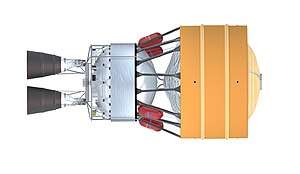Exploration Upper Stage
The Exploration Upper Stage (EUS) is being developed as a large second stage for Block 1B of the Space Launch System (SLS), succeeding Block 1's Interim Cryogenic Propulsion Stage. It will be powered by four RL10C-3[4] engines burning liquid oxygen and liquid hydrogen to produce a total of 440 kN (99,000 lbf) thrust. As of February 2015, the SLS Block 1B will provide thrust of 105 metric tons (231,000 lb).[5] The EUS is expected to first fly on Artemis IV.[6]
 Diagram of the Exploration Upper Stage | |
| Manufacturer | Boeing[1] |
|---|---|
| Country of origin | United States |
| Used on | SLS Block 1B[2] |
| General characteristics | |
| Height | not to exceed 18 m (60 ft) |
| Diameter | 8.4 m (28 ft) |
| Propellant mass | up to 129,000 kg (285,000 lb) |
| Engine details | |
| Engines | 4 RL10C-3[3][4] |
| Thrust | 440 kN (99,000 lbf) |
| Fuel | LOX/LH2 |
Development
The Block 1 configuration of SLS will have a core stage powered by four RS-25 engines, two Space Shuttle-derived five-segment solid rocket boosters, and an Interim Cryogenic Propulsion Stage upper stage.[7][8]
NASA will develop the EUS to increase SLS performance beyond Block 1 specifications. The improved upper stage was originally named the Dual Use Upper Stage (DUUS, pronounced "duce")[9] but was later renamed the Exploration Upper Stage (EUS) due to DUUS sounding like a profanity in Japanese.[10]
In 2014, NASA announced that it would proceed with development of Block 1B with the EUS,[11] and would use it on EM-2.[2] In April 2016, it was reported that NASA has chosen to use a design based on four RL10-C3 engines for the EUS,[3] and in October 2016 NASA confirmed they had ordered 10 of the engines.[4]
By February 2020 the development contract for EUS had been delayed and NASA was planning to use ICPS for the first three launches of SLS.[12]
Role and comparable stages
The EUS is to complete the SLS's ascent phase and then re-ignite to send its payload to destinations beyond low Earth orbit. This is a similar function to the S-IVB stage of the old Saturn V rocket, but the S-IV is comparable in also incorporating a cluster of RL-10 engines. The four RL10 engines on the EUS will produce slightly more thrust than the six RL10 engines of the S-IV.[13][14]
References
- "NASA, Boeing Finalize $2.8B SLS Core Stage Contract". SpaceNews.com. July 4, 2014. Retrieved July 25, 2014.
- "NASA confirms EUS for SLS Block IB design and EM-2 flight". NASASpaceflight.com. June 6, 2014. Retrieved July 25, 2014.
- Bergin, Chris (April 7, 2016). "MSFC propose Aerojet Rocketdyne supply EUS engines". NASASpaceFlight. Retrieved April 8, 2016.
- Proven Engine Packs Big, In-Space Punch for NASA’s SLS Rocket. Oct 2016
- "Advanced Boosters progress towards a solid future for SLS". NasaSpaceflight.com. February 20, 2015. Retrieved March 12, 2015.
- "NASA updates Lunar Gateway plans". NasaSpaceflight.com. September 11, 2018. Retrieved October 5, 2018.
- "SLS". Gunter's Space Page. Retrieved July 25, 2014.
- "Space Launch System Data Sheet". SpaceLaunchReport.com. Retrieved July 25, 2014.
- "SLS prepares for PDR – Evolution eyes Dual-Use Upper Stage". NASASpaceflight.com. June 2013. Retrieved July 25, 2014.
- Bergin, Chris (March 28, 2014). "SLS positioning for ARRM and Europa missions". NASA Spaceflight. Retrieved November 8, 2014.
- Bergin, Chris (July 30, 2012). "Wind Tunnel testing conducted on SLS configurations, including Block 1B". NASA SpaceFlight. Retrieved March 12, 2015.
- Upper Stage RL10s arrive at Stennis for upcoming SLS launches Feb 2020
- "SLS Launch Vehicle specifications take shape as development continues". NASASpaceflight.com. March 16, 2012. Retrieved July 24, 2014.
- "NASA's J-2X Engine To Be Mothballed After Testing". aviationweek.com. Retrieved August 16, 2016.